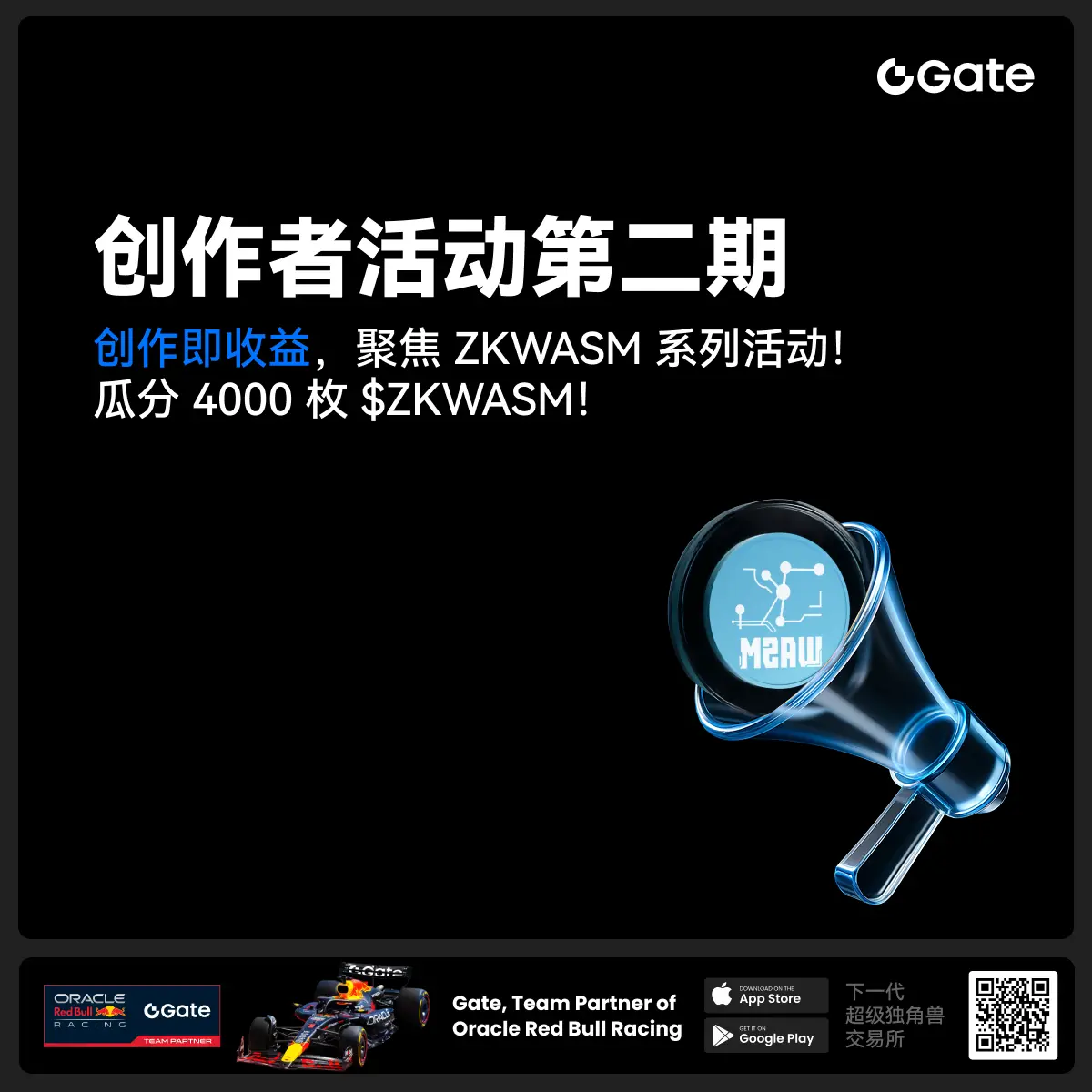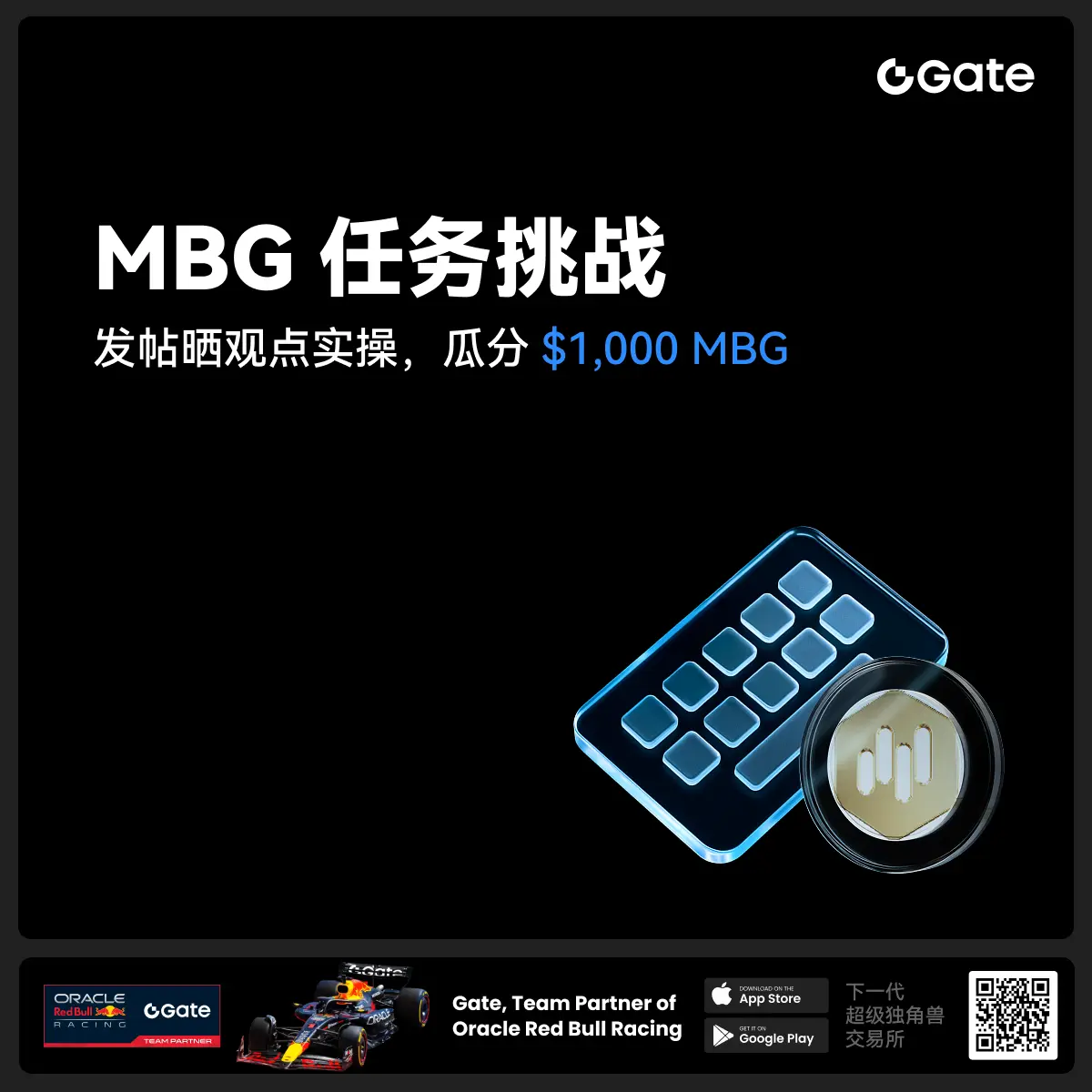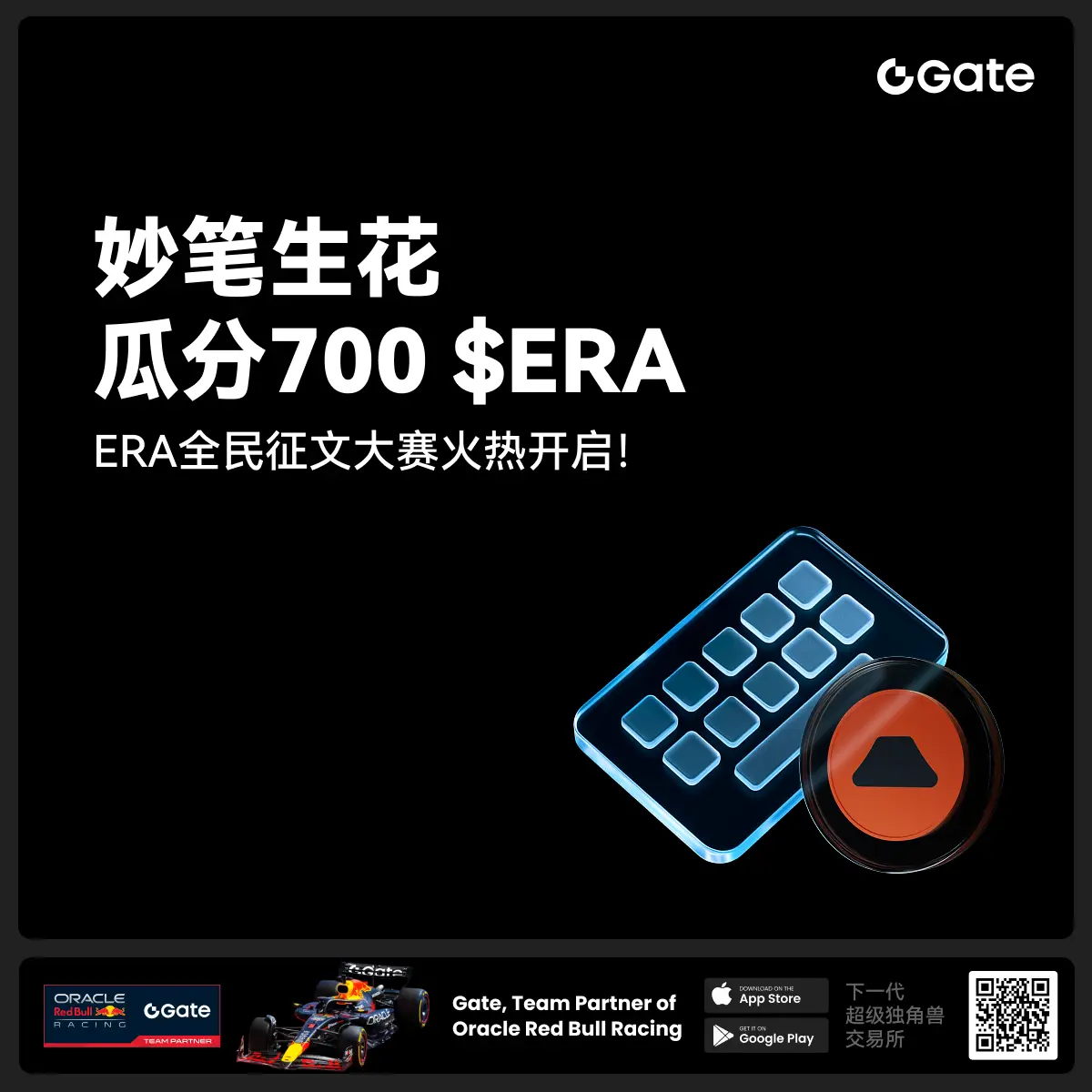- 话题1/3
45k 热度
2k 热度
2k 热度
166 热度
226 热度
- 置顶
- 📢 Gate广场 #创作者活动第二期# 正式开启!
聚焦 ZKWASM 系列活动,分享你的观点,瓜分 4,000 枚 $ZKWASM!
ZKWASM 作为 zk 公链先锋,正在 Gate 平台重磅推广!
三大活动联动上线:Launchpool 认购、CandyDrop 空投、Alpha 专属交易——不要错过!
🎨 活动一:发布广场贴文,赢内容奖励
📅 时间:7月25日 22:00 - 7月29日 22:00(UTC+8)
📌 参与方式:
- 在 Gate 广场发布与 ZKWASM 或其三大活动相关的原创内容(不少于 100 字)
- 添加标签: #创作者活动第二期# #ZKWASM#
- 附本人参与 Launchpool/CandyDrop/Alpha 的截图(如认购、空投或交易)
🏆 奖励设置:
- 一等奖(1名):1000 枚 $ZKWASM
- 二等奖(2名):500 枚 $ZKWASM
- 三等奖(10名):100 枚 $ZKWASM
📋 评选标准:内容质量、互动量、项目相关性,附活动参与截图者优先。
📢 活动二:发推赢传播力奖励
📌 参与方式:
- 在 X(推特)发布与 ZKWASM 或三大活动相关的原创内容(不少于 100 字)
- 添加标签: #ZKWASM # GateSquare
- 填写登记表 👉 https://www.gate.com/quest
- 📢 Gate广场 #MBG任务挑战# 发帖赢大奖活动火热开启!
想要瓜分1,000枚MBG?现在就来参与,展示你的洞察与实操,成为MBG推广达人!
💰️ 本期将评选出20位优质发帖用户,每人可轻松获得50枚MBG!
如何参与:
1️⃣ 调研MBG项目
对MBG的基本面、社区治理、发展目标、代币经济模型等方面进行研究,分享你对项目的深度研究。
2️⃣ 参与并分享真实体验
参与MBG相关活动(包括CandyDrop、Launchpool或现货交易),并晒出你的参与截图、收益图或实用教程。可以是收益展示、简明易懂的新手攻略、小窍门,也可以是现货行情点位分析,内容详实优先。
3️⃣ 鼓励带新互动
如果你的帖子吸引到他人参与活动,或者有好友评论“已参与/已交易”,将大幅提升你的获奖概率!
MBG热门活动(帖文需附下列活动链接):
Gate第287期Launchpool:MBG — 质押ETH、MBG即可免费瓜分112,500 MBG,每小时领取奖励!参与攻略见公告:https://www.gate.com/announcements/article/46230
Gate CandyDrop第55期:CandyDrop x MBG — 通过首次交易、交易MBG、邀请好友注册交易即可分187,500 MBG!参与攻略见公告:https://www.gate.com/announcements
- 📢 #Gate广场征文活动第三期# 正式启动!
🎮 本期聚焦:Yooldo Games (ESPORTS)
✍️ 分享独特见解 + 参与互动推广,若同步参与 Gate 第 286 期 Launchpool、CandyDrop 或 Alpha 活动,即可获得任意奖励资格!
💡 内容创作 + 空投参与 = 双重加分,大奖候选人就是你!
💰总奖池:4,464 枚 $ESPORTS
🏆 一等奖(1名):964 枚
🥈 二等奖(5名):每人 400 枚
🥉 三等奖(10名):每人 150 枚
🚀 参与方式:
在 Gate广场发布不少于 300 字的原创文章
添加标签: #Gate广场征文活动第三期#
每篇文章需 ≥3 个互动(点赞 / 评论 / 转发)
发布参与 Launchpool / CandyDrop / Alpha 任一活动的截图,作为获奖资格凭证
同步转发至 X(推特)可增加获奖概率,标签:#GateSquare 👉 https://www.gate.com/questionnaire/6907
🎯 双倍奖励机会:参与第 286 期 Launchpool!
质押 BTC 或 ESPORTS,瓜分 803,571 枚 $ESPORTS,每小时发放
时间:7 月 21 日 20:00 – 7 月 25 日 20:00(UTC+8)
🧠 写作方向建议:
Yooldo
- 🎉Gate 2025 上半年社区盛典:内容达人评选投票火热进行中 🎉
🏆 谁将成为前十位 #Gate广场# 内容达人?
投票现已开启,选出你的心头好
🎁赢取 iPhone 16 Pro Max、限量周边等好礼!
📅投票截止:8 月 15 日 10:00(UTC+8)
立即投票: https://www.gate.com/activities/community-vote
活动详情: https://www.gate.com/announcements/article/45974
- 📢 #Gate广场征文活动第二期# 正式启动!
分享你对 $ERA 项目的独特观点,推广ERA上线活动, 700 $ERA 等你来赢!
💰 奖励:
一等奖(1名): 100枚 $ERA
二等奖(5名): 每人 60 枚 $ERA
三等奖(10名): 每人 30 枚 $ERA
👉 参与方式:
1.在 Gate广场发布你对 ERA 项目的独到见解贴文
2.在贴文中添加标签: #Gate广场征文活动第二期# ,贴文字数不低于300字
3.将你的文章或观点同步到X,加上标签:Gate Square 和 ERA
4.征文内容涵盖但不限于以下创作方向:
ERA 项目亮点:作为区块链基础设施公司,ERA 拥有哪些核心优势?
ERA 代币经济模型:如何保障代币的长期价值及生态可持续发展?
参与并推广 Gate x Caldera (ERA) 生态周活动。点击查看活动详情:https://www.gate.com/announcements/article/46169。
欢迎围绕上述主题,或从其他独特视角提出您的见解与建议。
⚠️ 活动要求:
原创内容,至少 300 字, 重复或抄袭内容将被淘汰。
不得使用 #Gate广场征文活动第二期# 和 #ERA# 以外的任何标签。
每篇文章必须获得 至少3个互动,否则无法获得奖励
鼓励图文并茂、深度分析,观点独到。
⏰ 活动时间:2025年7月20日 17
LazAI研究:AI经济如何超越DeFi TVL神话
引言
去中心化金融(DeFi)通过一系列简单而强大的经济原语,点燃了指数级增长的故事,将区块链网络转变为全球无许可市场,彻底颠覆了传统金融。在 DeFi 的崛起中,几个关键指标成为了价值的通用语言:总锁定价值(TVL)、年化收益率(APY/APR)和流动性。这些简洁的指标激发了参与和信任。例如, 2020 年 DeFi 的 TVL(锁定在协议中的资产美元价值)飙升了 14 倍,随后在 2021 年再次翻四倍,峰值时突破 1120 亿美元。高收益率(某些平台在流动性挖矿热潮中宣称 APY 高达 3000% )吸引了流动性,而流动性池的深度则标志着更低的滑点和更高效的市场。简而言之,TVL 告诉我们“有多少资金参与其中”,APR 告诉我们“能赚取多少收益”,而流动性则表明“资产交易的便利程度”。尽管存在缺陷,但这些指标从零开始构建了一个价值数十亿美元的金融生态。通过将用户参与转化为直接的财务机会,DeFi 创造了一个自我强化的采用飞轮,使其迅速普及,推动大规模参与。
如今,AI 正处于相似的十字路口。但与 DeFi 不同,当前 AI 的叙事由基于海量互联网数据集训练的大型通用模型主导。这些模型往往难以在细分领域、专业任务或个性化需求中提供有效结果。它们的“一刀切”模式虽强大却脆弱,虽通用却错位。这一范式亟需转变。AI 的下一个时代不应由模型的规模或通用性定义,而应聚焦于自下而上——更小、高度专业化的模型。此类定制化 AI 需要一种全新的数据:高质量、与人类对齐且领域特定的数据。但获取此类数据并非像网络爬取那样简单,它需要个人、领域专家和社区的主动且有意识的贡献。
为了推动这一专业化、与人类对齐的 AI 新时代,我们需要构建类似于 DeFi 为金融设计的激励飞轮。这意味着引入新的 AI 原生原语,用于衡量数据质量、模型性能、代理可靠性和对齐激励——这些指标应直接反映数据作为资产(而非仅仅是输入)的真实价值。
本文将探讨这些能够构成 AI 原生经济支柱的新原语。我们将阐述:若建立正确的经济基础设施(即生成高质量数据、合理激励其创造与使用,并以个体为中心),AI 将如何蓬勃发展。我们还将以 LazAI 等平台为例,分析它们如何率先构建这些 AI 原生框架,引领定价和奖励数据的新范式,为 AI 创新的下一次飞跃提供动力。
DeFi 的激励飞轮:TVL、收益率与流动性——快速回顾
DeFi 的崛起并非偶然,其设计使得参与既有利可图又透明。总锁定价值(TVL)、年化收益率(APY/APR)和流动性等关键指标不仅是数字,更是将用户行为与网络增长对齐的原语。这些指标共同构成了吸引用户与资本的良性循环,进而推动进一步创新。
这些原语共同构成了强大的激励飞轮。通过锁定资产或提供流动性创造价值的参与者立即获得奖励(通过高收益和代币激励),从而鼓励更多参与。这使个体参与转化为广泛机会——用户赚取利润和治理影响力——而这些机会又催生网络效应,吸引数千用户加入。结果令人瞩目:截至 2024 年,DeFi 用户数超 1000 万,其价值在几年内增长近 30 倍。显然,大规模激励对齐——将用户转化为利益相关者——是 DeFi 指数级崛起的关键。
当前 AI 经济的缺失
如果说 DeFi 展示了自下而上的参与和激励对齐如何启动金融革命,那么当今 AI 经济仍缺乏支持类似转变的基础原语。当前 AI 由基于海量爬取数据集训练的大型通用模型主导。这些基础模型规模惊人,但旨在解决所有问题,总是往往无法特别有效地服务于任何人。其“一刀切”架构难以适应细分领域、文化差异或个体偏好,导致输出脆弱、存在盲点,且与现实需求日益脱节。
下一代 AI 的定义将不再仅是规模,还会有上下文理解能力——即模型理解和服务特定领域、专业社区及多元人类视角的能力。然而,这种情境智能需要不同的输入:高质量、与人类对齐的数据。而这正是当前所缺失的。目前尚无广泛认可的机制来衡量、识别、估值或优先化此类数据,也没有开放的流程供个人、社区或领域专家贡献其视角并改进日益影响其生活的智能系统。因此,价值仍集中在少数基础设施提供者手中,而大众与 AI 经济的上行潜力脱节。唯有设计出能够发掘、验证和奖励高价值贡献(数据、反馈、对齐信号)的新原语,我们才能解锁 DeFi 赖以繁荣的参与式增长循环。
简而言之,我们必须同样追问:
我们应如何衡量创造的价值?如何构建自我强化的采用飞轮,以推动以个体为中心的数据自下而上参与?
要解锁类似 DeFi 的“AI 原生经济”,我们需要定义新的原语,将参与转化为 AI 的机会,从而催化该领域迄今未见的网络效应。
AI 原生技术栈:新经济的新原语
我们不再只是将代币在钱包间转移,而是将数据输入模型、模型输出转化为决策、AI 代理付诸行动。这需要新的指标和原语,以量化智能与对齐,正如 DeFi 指标量化资本那样。例如,LazAI 正在构建下一代区块链网络,通过引入 AI 数据、模型行为和代理交互的新资产标准,解决 AI 数据对齐问题。
以下概述了定义链上 AI 经济价值的几项关键原语:
将其推广至通用 AI 经济,我们可能看到“总锁定数据价值(TDVL)”作为指标:网络所有有价值数据的聚合度量,按可验证性和有用性加权。已验证数据池甚至可像流动性池一样交易——例如,用于链上诊断 AI 的已验证医学影像池可能具有量化价值和利用率。数据溯源(了解数据来源、修改历史)将是该指标的关键部分,确保输入 AI 模型的数据可信且可追溯。本质上,如果说流动性关乎可用资本,可验证数据则关乎可用知识。数据价值证明(PoDV)等指标可捕捉网络中锁定的有用知识量,而通过 LazAI 的数据锚定代币(DAT)实现的链上数据锚定,使数据流动性成为可衡量、可激励的经济层。
已有平台开始代币化 AI 代理代币化并赋予链上指标:例如,Rivalz 的 “Rome protocol” 创建基于 NFT 的 AI 代理(rAgents),其最新声誉指标记录在链。用户可质押或出借这些代理,其奖励取决于代理在集体 AI“集群”中的表现与影响。这本质上是 AI 代理的 DeFi,并展示了代理效用指标的重要性。未来,我们可能像讨论活跃地址一样讨论“活跃 AI 代理”,或像讨论交易量一样讨论“代理经济影响”。
正如 DeFi 需要区块浏览器和仪表盘(如 DeFi Pulse、DefiLlama)追踪 TVL 和收益,AI 经济也需要新的浏览器追踪这些 AI 中心化指标——想象一个“AI-llama”仪表盘显示总对齐数据量、活跃 AI 代理数、累计 AI 效用收益等。其与 DeFi 有相似之处,但内容是全新的。
迈向 DeFi 式 AI 飞轮
我们需要为 AI 构建激励飞轮——将数据视为一等经济资产,从而将 AI 开发从封闭事业转变为开放、参与式经济,正如 DeFi 将金融变为用户驱动的流动性开放场域。
此方向的早期探索已现。例如,Vana等项目开始奖励用户参与数据共享。Vana 网络允许用户将个人或社区数据贡献至 DataDAO(去中心化数据池),并赚取数据集专属代币(可兑换为网络原生代币)。这是迈向数据贡献者货币化的重要一步。
然而,仅奖励贡献行为不足以复现 DeFi 的爆发式飞轮。在 DeFi 中,流动性提供者不仅因存入资产获得奖励,其提供的资产还具有透明市场价值,且收益反映实际使用(交易费、借贷利息加激励代币)。同理,AI 数据经济需超越泛泛奖励,直接为数据定价。若缺乏基于数据质量、稀缺性或对模型改进程度的经济定价,我们可能陷入浅层激励。单纯分发代币奖励参与可能鼓励数量而非质量,或在代币缺乏实际 AI 效用挂钩时停滞。要真正释放创新,贡献者需看到清晰的市场驱动信号,了解其数据价值,并在数据实际用于 AI 系统时获得回报。
我们需要一种更聚焦于直接估值和奖励数据的基础设施,以创建数据中心化激励循环:人们贡献的高质量数据越多,模型越优,吸引更多使用和数据需求,从而推高贡献者回报。这将使 AI 从争夺大数据的封闭竞赛,转变为可信、高质量数据的开放市场。
这些理念如何在真实项目中体现?以 LazAI 为例——该项目正在构建去中心化 AI 经济的下一代区块链网络和基础原语。
LazAI 简介——让 AI 与人类对齐
LazAI 是专为解决 AI 数据对齐问题而设计的下一代区块链网络和协议,通过引入 AI 数据、模型行为和代理交互的新资产标准,构建去中心化 AI 经济的基础设施。
LazAl 提供了最具前瞻性的方法之一,通过使数据可验证、激励和可编程于链上解决了 AI 对齐问题。下文将会以 LazAI 的框架为例来说明 Al 原生区块链如何将上述原则付诸实践。
核心问题——数据错位与缺乏公平激励
AI 对齐常归结于训练数据质量,而未来需要与人类对齐、可信且受治理的新数据。随着 AI 行业从中心化通用模型转向情境化、对齐化智能,基础设施必须同步进化。下一 AI 时代将由对齐性、精确性与溯源性定义。LazAI 直击数据对齐与激励挑战,提出根本解决方案:在源头对齐数据并直接奖励数据本身。换言之,确保训练数据可验证地代表人类视角、去噪/去偏,并根据数据质量、稀缺性或对模型的改进程度给予奖励。这是从修补模型到整理数据的范式跃迁。
LazAI 不仅引入原语,更提出数据获取、定价与治理的新范式。其核心概念包括数据锚定代币(DAT)和以个体为中心的 DAO(iDAO),二者共同实现数据的定价、溯源与可编程使用。
可验证与可编程数据——数据锚定代币(DAT)
为实现这一目标,LazAI 引入了一种新的链上原语——数据锚定代币(DAT),一个专为 AI 数据资产化设计的新型通证标准。每个 DAT 代表一条链上锚定的数据及其沿袭信息:贡献者身份、随时间推移的演变历程,以及使用场景。这为每条数据创建了可验证的历史记录——类似于数据集的版本控制系统(如 Git),但由区块链保障安全性。由于 DAT 存在于链上,它们具备可编程性:智能合约可管理其使用规则。例如,数据贡献者可指定其 DAT(如一组医学影像)仅限特定 AI 模型访问,或在特定条件下使用(通过代码强制实施隐私或道德约束)。激励机制则体现在 DAT 可交易或质押——若数据对模型有价值,模型(或其所有者)可能付费获取 DAT 的访问权。本质上,LazAI 构建了一个数据代币化且可溯源的市场。这直接呼应前文讨论的“可验证数据”指标:通过检查 DAT,可确认其是否已验证、被多少模型使用,以及带来何种模型性能提升。此类数据将获得更高估值。通过将数据锚定在链上,并将经济激励与质量挂钩,LazAI 确保 AI 训练于可信且可衡量的数据。这是通过激励对齐解决问题——优质数据获得奖励并脱颖而出。
以个体为中心的 DAO(iDAO)框架
第二个关键组件是 LazAI 的 iDAO(以个体为中心的 DAO)概念,其通过将个体(而非组织)置于决策与数据所有权的核心,重新定义了 AI 经济中的治理模式。传统 DAO 通常优先考虑集体组织目标,无意中弱化了个体意志。iDAO 则颠覆了这一逻辑。它们是个性化治理单元,允许个人、社区或领域特定实体直接拥有、控制并验证其贡献给 AI 系统的数据和模型。iDAO 支持定制化、对齐的 AI:作为治理框架,它们确保模型始终遵循贡献者的价值观或意图。从经济角度看,iDAO 还使 AI 行为具备社区的可编程性——可设定规则限制模型如何使用特定数据、谁可访问模型,以及模型产出收益的分配方式。例如,iDAO 可规定:每当其 AI 模型被调用(如 API 请求或任务完成)时,部分收益将返还给贡献相关数据的 DAT 持有者。这建立了代理行为与贡献者奖励之间的直接反馈循环——类似于 DeFi 中流动性提供者收益与平台使用挂钩的机制。此外,iDAO 之间可通过协议实现可组合性交互:一个 AI 代理(iDAO)可在协商条款下调用另一 iDAO 的数据或模型。
通过建立这些原语,LazAI 的框架将去中心化 AI 经济的愿景变为现实。数据成为用户可拥有并从中获利的资产,模型从私有孤岛转变为协作项目,每位参与者——从策划独特数据集的个体到构建小型专业模型的开发者——都能成为 AI 价值链的利益相关者。这种激励对齐有望复现 DeFi 的爆发式增长:当人们意识到参与 AI(贡献数据或专业知识)直接转化为机会时,他们将更积极地投入。随着参与者增多,网络效应随之启动——更多数据催生更优模型,吸引更多用户,进而生成更多数据与需求,形成正向循环。
构建 AI 信任基座:可验证计算框架
在这一生态体系中,LazAI 的可验证计算框架(Verified Computing Framework)是构建信任的核心层。该框架确保每个生成的 DAT、每个 iDAO(个体化自治组织)决策、每笔激励分配都有可验证的追溯链条,使数据所有权可执行、治理过程可追责、智能体行为可审计。通过将 iDAO 与 DAT 从理论概念转化为可靠可验证的系统,可验证计算框架实现了信任的范式转移——从依赖假设转向基于数学验证的确定性保障。
去中心化 AI 经济的价值实现
这套基础要素的建立,使得去中心化 AI 经济的愿景真正落地:
这种激励相容设计有望复现 DeFi 的增长动能:当用户意识到参与 AI 建设(通过贡献数据或专业知识)能直接转化为经济机遇时,参与热情将被点燃。随着参与者规模扩大,网络效应随之显现——更多高质量数据催生更优模型,吸引更多用户加入,进而产生更多数据需求,形成自我强化的增长飞轮。
结语:迈向开放的 AI 经济
DeFi 的历程表明,正确的原语能释放前所未有的增长。在即将到来的 AI 原生经济中,我们正站在类似突破的临界点。通过定义并落地重视数据与对齐的新原语,我们可将 AI 开发从中心化工程转变为去中心化的社区驱动事业。这一旅程不乏挑战:需确保经济机制优先质量而非数量,并规避道德陷阱以防止数据激励损害隐私或公平。但方向已然清晰。LazAI 的 DAT 与 iDAO 等实践正开辟道路,将“与人类对齐的 AI”抽象理念转化为所有权与治理的具体机制。
正如早期 DeFi 通过实验性优化 TVL、流动性挖矿和治理,AI 经济也将迭代其新原语。未来,围绕数据价值衡量、公平奖励分配、AI 代理对齐与益处的辩论与创新必将涌现。本文仅触及可能推动 AI 民主化的激励模型之表层,期望激发开放讨论与深入研究:如何设计更多 AI 原生经济原语?可能产生哪些意外后果或机遇?通过广泛社区的参与,我们更可能构建一个不仅技术先进,且经济包容、与人类价值观对齐的 AI 未来。
DeFi 的指数级增长并非魔法——它由激励对齐驱动。如今,我们有机会通过数据与模型的同类实践,推动一场 AI 复兴。将参与转化为机会,机会转化为网络效应,我们可为 AI 启动重塑数字时代价值创造与分配的飞轮。
让我们共同构建这一未来——从一条可验证数据集、一个对齐的 AI 代理、一项新原语开始。